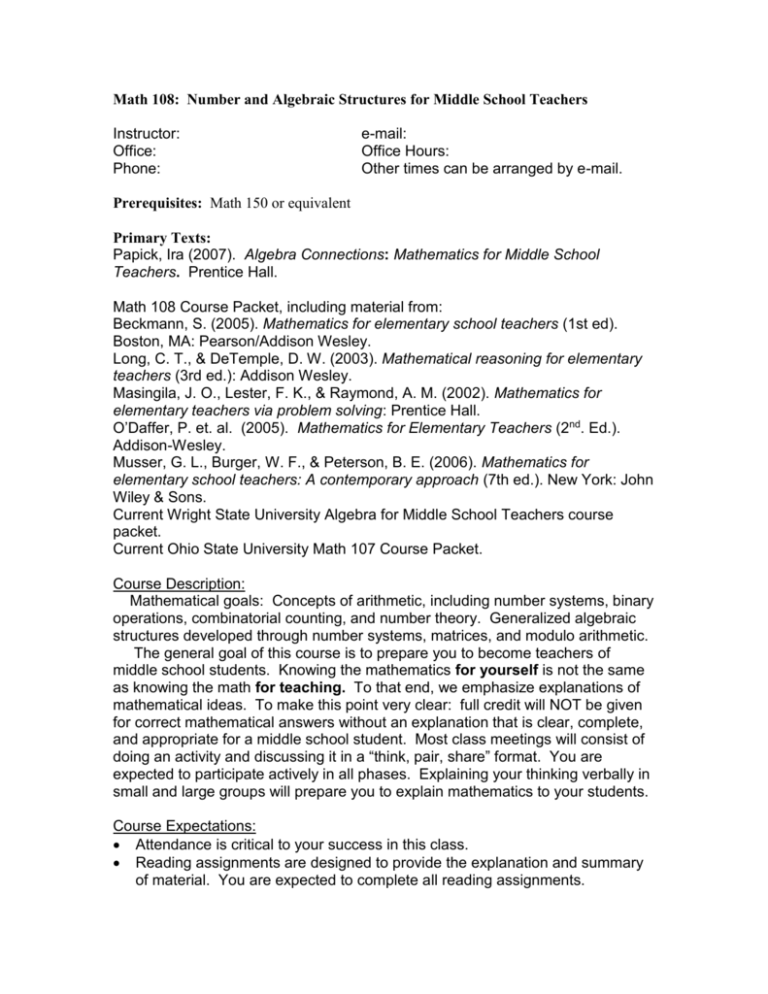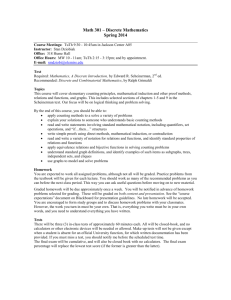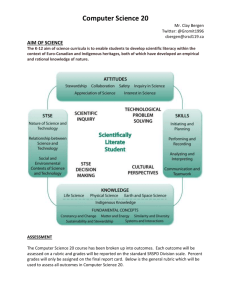
Math 108: Number and Algebraic Structures for Middle School Teachers
Instructor:
Office:
Phone:
e-mail:
Office Hours:
Other times can be arranged by e-mail.
Prerequisites: Math 150 or equivalent
Primary Texts:
Papick, Ira (2007). Algebra Connections: Mathematics for Middle School
Teachers. Prentice Hall.
Math 108 Course Packet, including material from:
Beckmann, S. (2005). Mathematics for elementary school teachers (1st ed).
Boston, MA: Pearson/Addison Wesley.
Long, C. T., & DeTemple, D. W. (2003). Mathematical reasoning for elementary
teachers (3rd ed.): Addison Wesley.
Masingila, J. O., Lester, F. K., & Raymond, A. M. (2002). Mathematics for
elementary teachers via problem solving: Prentice Hall.
O’Daffer, P. et. al. (2005). Mathematics for Elementary Teachers (2nd. Ed.).
Addison-Wesley.
Musser, G. L., Burger, W. F., & Peterson, B. E. (2006). Mathematics for
elementary school teachers: A contemporary approach (7th ed.). New York: John
Wiley & Sons.
Current Wright State University Algebra for Middle School Teachers course
packet.
Current Ohio State University Math 107 Course Packet.
Course Description:
Mathematical goals: Concepts of arithmetic, including number systems, binary
operations, combinatorial counting, and number theory. Generalized algebraic
structures developed through number systems, matrices, and modulo arithmetic.
The general goal of this course is to prepare you to become teachers of
middle school students. Knowing the mathematics for yourself is not the same
as knowing the math for teaching. To that end, we emphasize explanations of
mathematical ideas. To make this point very clear: full credit will NOT be given
for correct mathematical answers without an explanation that is clear, complete,
and appropriate for a middle school student. Most class meetings will consist of
doing an activity and discussing it in a “think, pair, share” format. You are
expected to participate actively in all phases. Explaining your thinking verbally in
small and large groups will prepare you to explain mathematics to your students.
Course Expectations:
Attendance is critical to your success in this class.
Reading assignments are designed to provide the explanation and summary
of material. You are expected to complete all reading assignments.
There will be weekly homework assignments, usually due on Fridays.
Homework assignments will receive a score out of 15 points: you will receive
5 points for completing all of the problems (less if you do not) and ONE
randomly selected problem will be graded on the 10-point grading rubric
shown on the following page. The graded problem will be assessed on both
the quality of your explanation and the correctness of your solution.
Occasionally, a score will be given that is not on the rubric (e.g., a “1” or a
“7.5”). This indicates that your work is between two scores.
Homework revision policy:
1)
One homework score AND one quiz score will be dropped at the
end of the quarter.
2)
If you score a 6 or less out of 10 on a graded homework problem,
you may submit a revision of that problem. Here are the requirements:
a. Resubmit the original homework assignment with your TA’s comments.
b. Explain what went wrong in the first try.
c. Submit the revised problem solution.
d. This revision must be returned no later than one week after you have
received your graded paper.
e. You may earn up to half the missed points. These will be added to the
original score for your final score.
3)
The revision policy applies only to the graded problem, not to your
completion score.
Each Friday after the first week (except for midterm exam week), there will be
a short quiz on material taken from the class activities indicated in the
syllabus for that week. These activities will be completed and discussed in
lecture and recitation. Activities not completed in class should be finished at
home—on quizzes, you will be responsible for all the material in the assigned
activity. Quizzes will be graded on the 10-point grading rubric shown on the
following page.
There will be no makeup quizzes. As was stated above, the lowest
homework score and lowest quiz score will be dropped at the end of the
quarter; this will compensate for a missed quiz.
Exams: There will be a midterm exam and a final exam. If you have a
legitimate conflict (work, class, etc.), please see me with documentation as
soon as possible so we can arrange a makeup time (preferably the following
morning). Exam problems will be graded according to the 10-point rubric
shown below.
Grading Rubric
# of
Description
points
10
Very good
8
Good
6
4
Basic
Emerging
2
Credit for
effort
No credit
0
Characteristics
Correct mathematics that is carefully thought out
and thoroughly explained
Correct mathematics with emerging but incomplete
explanation
Correct mathematics but little or no explanation
Work that has some merit, but also has significant
shortcomings in the mathematics and/or the
explanation
Work that shows some relevant effort but is
seriously flawed
No work submitted or no serious effort shown
Final grades will be computed according to the following weighting system:
Attendance/Participation: 10%
Homework:
17.5%
Quizzes:
17.5%
Midterm exam:
20%
Final exam:
35%
A. Disability Statement. Students with disabilities that have been certified by
the Office for Disability Services will be appropriately accommodated, and should
inform the instructor as soon as possible of their needs. The Office for Disability
Services is located in 150 Pomerene Hall, 1760 Neil Avenue; telephone 2923307, TDD 292-0901; http://www.ods.ohio-state.edu/.
B. Academic Misconduct Statement. It is the responsibility of the Committee
on Academic Misconduct to investigate or establish procedures for the
investigation of all reported cases of student academic misconduct. The term
“academic misconduct” includes all forms of student academic misconduct
wherever committed; illustrated by, but not limited to, cases of plagiarism and
dishonest practices in connection with examinations. Instructors shall report all
instances of alleged academic misconduct to the committee. For additional
information, see the Code of Student Conduct :
http://studentaffairs.osu.edu/resource_csc.asp
Tentative Schedule
Week
1-2
Topic
Number Systems (Course Packet)
Definitions, mathematical contexts, notation.
Algorithms for comparison of Natural, Integer, Rational, Real, and
Complex numbers.
Place value structure.
Decimal and rational representation; conversion between these.
Irrational numbers.
2-3
Addition and Subtraction: (Course Packet)
Set definitions, meaning of operations for integers and rationals.
Justification of algorithms and mental computations for integers and
rationals.
Building from meaning of these operations with numbers to
addition/subtraction of variables.
3-4
Multiplication and Division: (Course Packet)
Set definitions, meaning of operations for integers and rationals.
Justification of algorithms and mental computations for integers and
rationals.
Building from meaning of these operations with numbers to
multiplication/division of variables.
5
Exponent and roots/logs (Course Packet)
Definitions, meaning of operations.
Justification of algorithms and mental computations.
Building from meaning of these operations with numbers to
meaning with variables.
6
Combinatorial counting (Course Packet; Papick, Chap. 1)
Fundamental counting principle and applications
Permutations and combinations
Inclusion/Exclusion.
7
Number Theory (Papick, Chap. 2)
Factors and primes
Fundamental Theorem of Arithmetic
LCM and GCF.
8
Divisibility (Papick, Chaps. 3&4)
Divisibility tests
Euclidean Algorithm.
9
Algebraic Structures (Papick, Chap. 4)
Concept of inverse
Number systems and binary operations as group/ring/field
Modular arithmetic.
10
Algebra of matrices (Papick, Chap. 6)
Systems of linear equations
Matrices
Matrix arithmetic
Practical applications.








